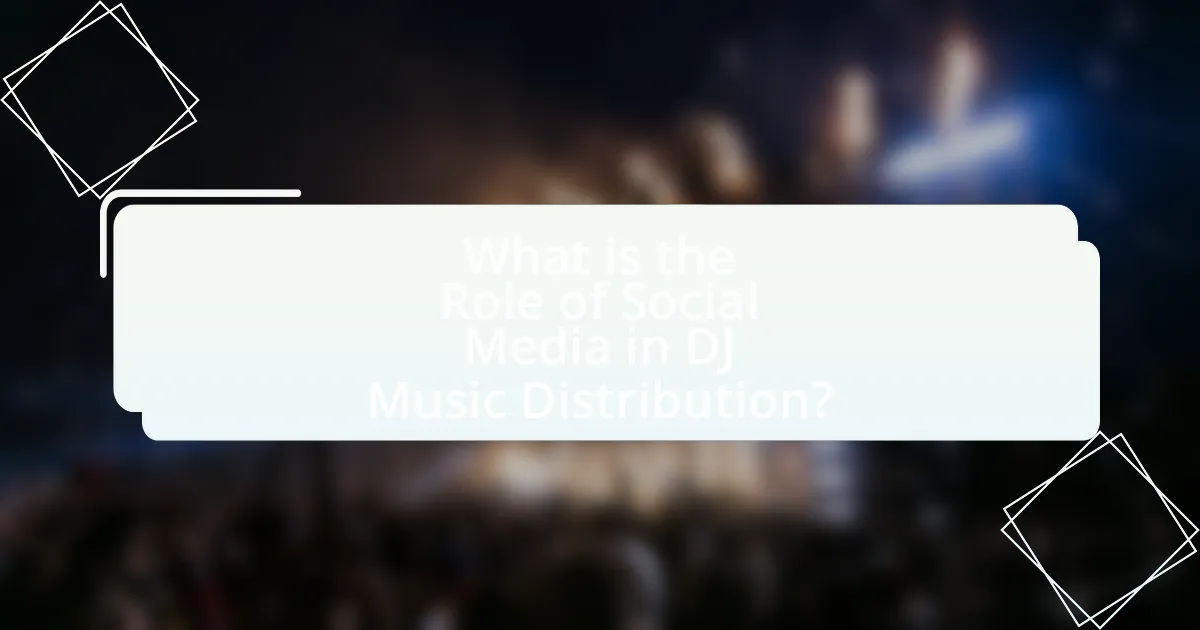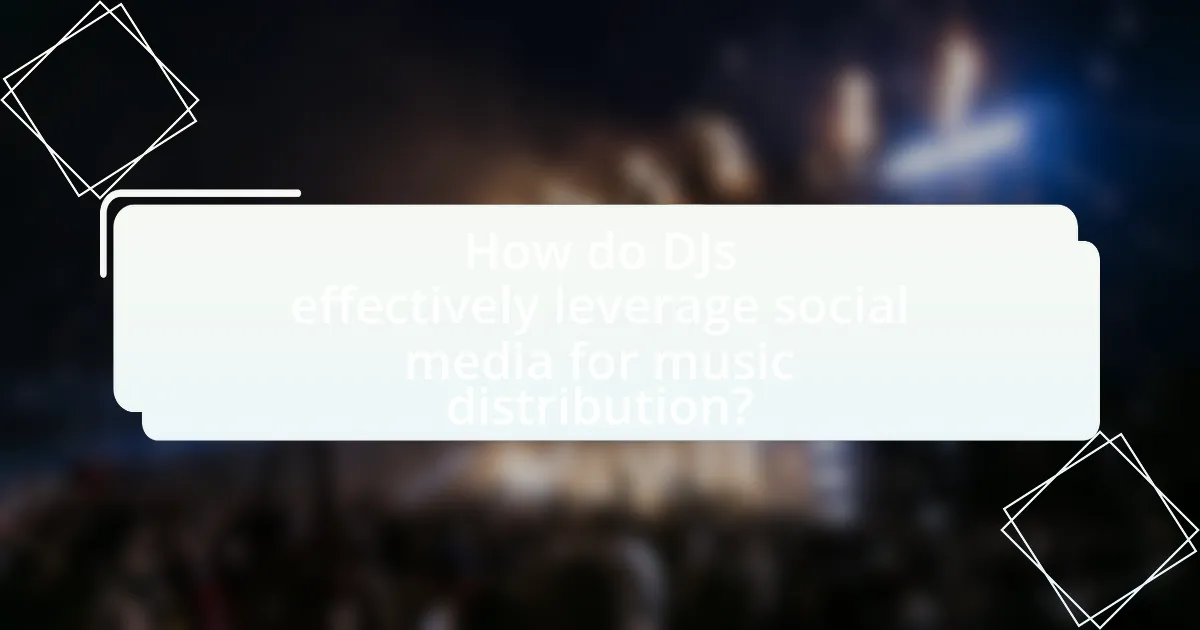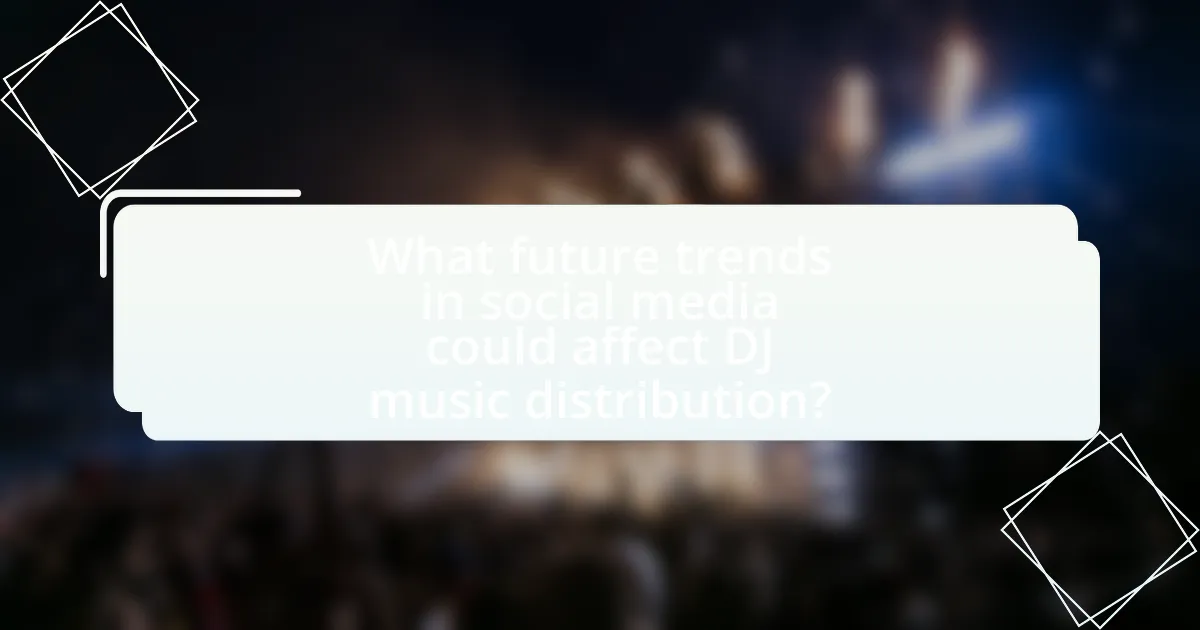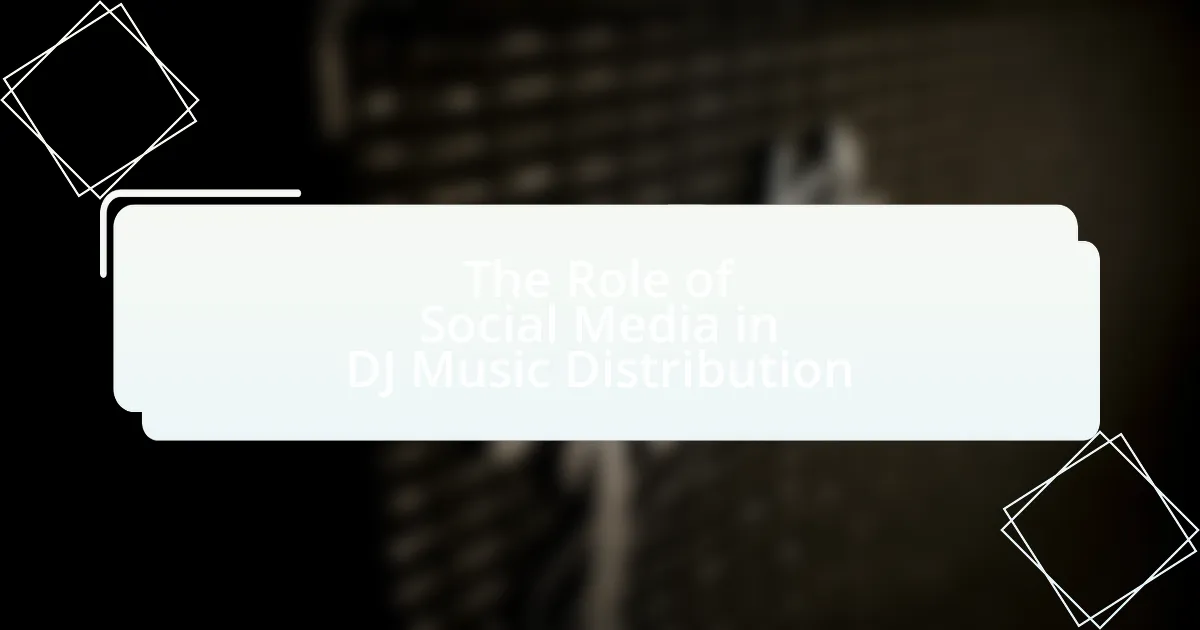The article examines the significant role of social media in DJ music distribution, highlighting how platforms like SoundCloud, Instagram, and TikTok enable DJs to share their music, engage with fans, and promote events. It discusses the transformation of music distribution through direct audience engagement, the advantages of using social media for increased reach and cost-effective promotion, and the challenges DJs face, such as copyright issues and algorithm changes. Additionally, the article outlines effective strategies for maximizing reach, maintaining authenticity, and measuring success, while also exploring future trends and technologies that may influence DJ music distribution on social media.

What is the Role of Social Media in DJ Music Distribution?
Social media plays a crucial role in DJ music distribution by providing platforms for DJs to share their music, engage with fans, and promote events. Through channels like Instagram, Facebook, and SoundCloud, DJs can reach a global audience, allowing for immediate feedback and interaction. For instance, a study by the International Journal of Music Business Research found that 70% of DJs use social media to distribute their music and connect with listeners, highlighting its effectiveness in building a fanbase and increasing visibility. This direct engagement not only enhances the promotional efforts of DJs but also facilitates the discovery of new music by fans, making social media an essential tool in the modern music distribution landscape.
How has social media transformed the landscape of music distribution for DJs?
Social media has fundamentally transformed music distribution for DJs by enabling direct engagement with audiences and facilitating the rapid sharing of music. Platforms like SoundCloud, Instagram, and TikTok allow DJs to upload and promote their tracks instantly, reaching global audiences without traditional gatekeepers like record labels. For instance, TikTok’s viral trends have led to significant increases in song streams, with tracks gaining millions of plays after being featured in user-generated content. This shift has democratized music distribution, allowing emerging DJs to gain visibility and build fanbases through organic social media interactions, as evidenced by the rise of independent artists who leverage these platforms for promotion.
What are the key social media platforms used by DJs for music distribution?
DJs primarily use platforms like SoundCloud, Instagram, Facebook, and YouTube for music distribution. SoundCloud allows DJs to upload and share their tracks, reaching a wide audience and facilitating interaction with fans. Instagram serves as a visual platform where DJs can promote their music and engage with followers through stories and posts. Facebook provides a community space for sharing events, music, and updates, while YouTube is essential for distributing music videos and live sets, attracting millions of viewers. These platforms collectively enhance visibility and accessibility for DJs in the music industry.
How do DJs utilize social media to reach their audience?
DJs utilize social media to reach their audience by creating engaging content, promoting events, and interacting directly with fans. Platforms like Instagram, Facebook, and TikTok allow DJs to share snippets of their performances, behind-the-scenes footage, and personal updates, which fosters a sense of community and connection. According to a 2021 survey by the International Music Summit, 70% of DJs reported that social media significantly increased their fan engagement and event attendance. This direct interaction not only helps in building a loyal fan base but also enhances their visibility in a competitive industry.
What are the advantages of using social media for DJ music distribution?
The advantages of using social media for DJ music distribution include increased reach, direct audience engagement, and cost-effectiveness. Social media platforms allow DJs to share their music with a global audience instantly, significantly expanding their listener base compared to traditional distribution methods. For instance, platforms like SoundCloud and Instagram enable DJs to post tracks and engage with fans through comments and shares, fostering a community around their music. Additionally, social media marketing is often more affordable than traditional advertising, allowing DJs to promote their work without substantial financial investment. According to a 2021 report by Statista, 54% of social media users utilize these platforms for discovering new music, highlighting the effectiveness of social media in reaching potential listeners.
How does social media enhance audience engagement for DJs?
Social media enhances audience engagement for DJs by providing platforms for direct interaction and real-time feedback. DJs can share their music, promote events, and connect with fans through posts, stories, and live streams, fostering a sense of community. For instance, a study by the Pew Research Center found that 69% of adults in the U.S. use social media, allowing DJs to reach a broad audience quickly. Additionally, social media algorithms can amplify a DJ’s reach, as engaging content is more likely to be shared, increasing visibility and interaction. This dynamic interaction not only keeps fans informed but also encourages them to participate in discussions, share experiences, and promote the DJ’s brand, ultimately enhancing overall engagement.
What cost-effective strategies do DJs use on social media for music promotion?
DJs utilize several cost-effective strategies on social media for music promotion, including engaging content creation, leveraging user-generated content, and utilizing targeted advertising. Engaging content creation involves sharing behind-the-scenes footage, live performances, and interactive posts that resonate with their audience, fostering a community around their music. User-generated content, such as reposting fans’ videos or photos, enhances authenticity and encourages further engagement, as seen in campaigns where DJs encourage fans to share their experiences. Targeted advertising on platforms like Facebook and Instagram allows DJs to reach specific demographics without significant financial investment, often yielding high engagement rates. These strategies are supported by data indicating that social media engagement can lead to increased streaming numbers and ticket sales, demonstrating their effectiveness in music promotion.
What challenges do DJs face when using social media for music distribution?
DJs face several challenges when using social media for music distribution, including copyright issues, algorithm changes, and audience engagement. Copyright issues arise because platforms often restrict the use of copyrighted music, which can limit a DJ’s ability to share their mixes or original tracks. Algorithm changes on social media platforms can affect the visibility of posts, making it difficult for DJs to reach their audience consistently. Additionally, engaging an audience on social media requires ongoing content creation and interaction, which can be time-consuming and detract from a DJ’s focus on music production and performance. These challenges highlight the complexities DJs encounter in leveraging social media effectively for music distribution.
How do algorithm changes on social media platforms impact DJ visibility?
Algorithm changes on social media platforms significantly impact DJ visibility by altering how their content is distributed and discovered. For instance, when platforms like Instagram or TikTok modify their algorithms to prioritize certain types of content, DJs may experience fluctuations in engagement and reach. A study by Hootsuite in 2021 indicated that algorithm updates can lead to a 30% decrease in visibility for creators who do not adapt to new content formats or engagement strategies. This means that DJs who fail to align their promotional tactics with these changes may struggle to maintain their audience and visibility, ultimately affecting their music distribution and fan engagement.
What are the common pitfalls DJs encounter in social media marketing?
DJs commonly encounter several pitfalls in social media marketing, including inconsistent branding, lack of engagement, and neglecting analytics. Inconsistent branding can confuse followers and dilute a DJ’s identity, making it difficult to build a loyal fan base. Lack of engagement with followers can lead to decreased visibility and missed opportunities for connection, as social media algorithms favor active accounts. Neglecting analytics prevents DJs from understanding their audience’s preferences and optimizing their content strategy, which can hinder growth. According to a study by Hootsuite, brands that engage with their audience see a 20-40% increase in customer loyalty, highlighting the importance of active participation in social media marketing.

How do DJs effectively leverage social media for music distribution?
DJs effectively leverage social media for music distribution by utilizing platforms like Instagram, Facebook, and SoundCloud to share their tracks and engage with their audience. These platforms allow DJs to reach a global audience instantly, promoting new releases and live performances. For example, a study by the International Journal of Music Business Research found that 70% of independent artists use social media to distribute their music, highlighting its importance in the industry. Additionally, social media enables DJs to build a personal brand, interact with fans, and collaborate with other artists, further enhancing their reach and visibility in the music market.
What strategies can DJs implement to maximize their reach on social media?
DJs can maximize their reach on social media by consistently engaging with their audience through regular content updates, live streams, and interactive posts. Regularly posting high-quality content, such as mixes, behind-the-scenes footage, and personal stories, keeps followers interested and encourages sharing. Live streaming performances or Q&A sessions fosters real-time interaction, enhancing community engagement. Utilizing targeted advertising on platforms like Facebook and Instagram can also expand their audience by reaching specific demographics interested in their music genre. According to a study by Hootsuite, brands that engage with their audience on social media see a 20-40% increase in customer loyalty, which is crucial for DJs looking to build a dedicated fan base.
How can DJs create engaging content that resonates with their audience?
DJs can create engaging content that resonates with their audience by leveraging social media platforms to share authentic experiences and interactive elements. By posting behind-the-scenes footage, live performance clips, and personal stories, DJs can foster a deeper connection with their followers. Research indicates that 54% of social media users prefer content that showcases the personality of the creator, highlighting the importance of authenticity in engagement. Additionally, incorporating audience feedback through polls, Q&A sessions, and live chats can enhance interaction, making followers feel valued and involved in the creative process. This approach not only builds community but also increases the likelihood of content being shared, further expanding reach and engagement.
What role do collaborations play in enhancing a DJ’s social media presence?
Collaborations significantly enhance a DJ’s social media presence by expanding their reach and audience engagement. When DJs collaborate with other artists, they tap into each other’s fan bases, which can lead to increased followers and interactions on social media platforms. For instance, a study by the International Journal of Music Business Research found that artists who collaborate often see a 30% increase in social media engagement within the first month of releasing collaborative content. This increase is attributed to shared promotional efforts and cross-pollination of audiences, making collaborations a strategic tool for DJs to elevate their visibility and connect with new listeners.
How can DJs measure the success of their social media distribution efforts?
DJs can measure the success of their social media distribution efforts through key performance indicators (KPIs) such as engagement rates, follower growth, and conversion metrics. Engagement rates, which include likes, shares, comments, and saves, provide insight into how well the content resonates with the audience. For instance, a study by Sprout Social found that posts with higher engagement rates typically lead to increased brand awareness and loyalty. Follower growth indicates the expanding reach of the DJ’s brand, while conversion metrics, such as ticket sales or streaming numbers linked to social media campaigns, directly reflect the effectiveness of promotional efforts. By analyzing these metrics, DJs can assess the impact of their social media strategies on their overall success.
What metrics should DJs track to evaluate their social media impact?
DJs should track engagement metrics, follower growth, reach, and conversion rates to evaluate their social media impact. Engagement metrics, such as likes, shares, and comments, indicate how well content resonates with the audience. Follower growth reflects the effectiveness of outreach efforts, while reach measures the total number of unique users who see posts. Conversion rates, which track actions taken by users (like streaming music or purchasing tickets), provide insight into how social media efforts translate into tangible results. According to a 2021 study by Hootsuite, posts with higher engagement rates lead to increased visibility and follower growth, reinforcing the importance of these metrics for DJs.
How can feedback from social media inform a DJ’s music distribution strategy?
Feedback from social media can significantly inform a DJ’s music distribution strategy by providing real-time insights into audience preferences and engagement levels. By analyzing comments, shares, and likes on platforms such as Instagram, Twitter, and Facebook, DJs can identify which tracks resonate most with their listeners. For instance, a study by the International Journal of Music Business Research found that 70% of music consumers are influenced by social media interactions when deciding to stream or purchase music. This data allows DJs to tailor their distribution efforts, focusing on platforms and formats that yield the highest engagement, ultimately enhancing their reach and effectiveness in connecting with their audience.

What future trends in social media could affect DJ music distribution?
Future trends in social media that could affect DJ music distribution include the rise of short-form video content and the integration of augmented reality (AR) experiences. Short-form video platforms like TikTok have already demonstrated their ability to propel songs to viral status, significantly impacting music distribution by allowing DJs to reach wider audiences quickly. Additionally, AR features on platforms such as Instagram and Snapchat can create immersive experiences for fans, enhancing engagement and promoting music in innovative ways. These trends indicate a shift towards more interactive and visually engaging content, which can lead to increased visibility and distribution opportunities for DJs.
How might emerging technologies influence DJ music distribution on social media?
Emerging technologies significantly influence DJ music distribution on social media by enabling innovative methods for content creation, sharing, and audience engagement. For instance, advancements in artificial intelligence allow DJs to create personalized playlists and remixes tailored to individual listener preferences, enhancing user experience and increasing shareability on platforms like Instagram and TikTok. Additionally, blockchain technology facilitates transparent royalty distribution, ensuring that DJs receive fair compensation for their work when shared across social media channels. According to a report by the International Music Summit, the integration of these technologies is reshaping the music industry, with 70% of DJs utilizing social media for promotional purposes, highlighting the critical role of these platforms in modern music distribution.
What role will live streaming play in the future of DJ music distribution?
Live streaming will play a crucial role in the future of DJ music distribution by providing real-time engagement and access to global audiences. As platforms like Twitch and YouTube Live gain popularity, DJs can reach fans directly, bypassing traditional distribution channels. This shift allows for immediate feedback and interaction, enhancing the listener experience. According to a report by Statista, the global live streaming market is projected to reach $247 billion by 2027, indicating a growing trend that DJs can leverage for wider exposure and monetization opportunities.
How can DJs prepare for changes in social media algorithms and user behavior?
DJs can prepare for changes in social media algorithms and user behavior by diversifying their content strategies and engaging with their audience across multiple platforms. By creating a variety of content types, such as videos, live streams, and interactive posts, DJs can adapt to shifting user preferences and algorithm updates that favor different formats. For instance, a study by Hootsuite in 2021 indicated that video content receives 1200% more shares than text and image content combined, highlighting the importance of video in social media engagement. Additionally, DJs should regularly analyze their audience insights and engagement metrics to understand trends and adjust their strategies accordingly, ensuring they remain relevant and visible in a constantly evolving digital landscape.
What best practices should DJs follow for effective social media music distribution?
DJs should consistently engage their audience, utilize analytics, and maintain a strong brand presence for effective social media music distribution. Engaging with followers through regular posts, live sessions, and responding to comments fosters community and loyalty. Utilizing analytics tools, such as Facebook Insights or Instagram Analytics, allows DJs to understand their audience’s preferences and optimize content accordingly. Maintaining a cohesive brand presence across platforms, including consistent visuals and messaging, helps in building recognition and trust. According to a study by Hootsuite, brands that actively engage with their audience see a 20-40% increase in customer loyalty, highlighting the importance of these practices in music distribution.
How can DJs maintain authenticity while promoting their music on social media?
DJs can maintain authenticity while promoting their music on social media by sharing personal stories and experiences related to their music. This approach fosters a genuine connection with their audience, as it allows fans to see the individual behind the brand. For instance, when DJs post behind-the-scenes content or discuss their creative process, they provide insight into their artistic journey, which resonates with followers. Research indicates that 70% of consumers prefer to learn about a brand through articles rather than ads, highlighting the effectiveness of storytelling in building trust and authenticity. By prioritizing transparency and engaging with their audience through authentic content, DJs can effectively promote their music while staying true to their identity.
What are the key elements of a successful social media marketing plan for DJs?
A successful social media marketing plan for DJs includes audience engagement, content strategy, platform selection, analytics, and collaboration. Audience engagement involves interacting with fans through comments, live streams, and Q&A sessions, which fosters community and loyalty. A content strategy should focus on high-quality visuals, music samples, and behind-the-scenes footage to showcase the DJ’s personality and brand. Platform selection is crucial; DJs should prioritize platforms like Instagram, TikTok, and Facebook, where their target audience is most active. Utilizing analytics helps DJs track performance metrics, allowing for data-driven adjustments to their strategy. Collaboration with other artists and influencers can expand reach and introduce the DJ to new audiences, enhancing visibility and growth. These elements are supported by industry trends showing that DJs who actively engage on social media see increased fan interaction and event attendance.

Leave a Reply